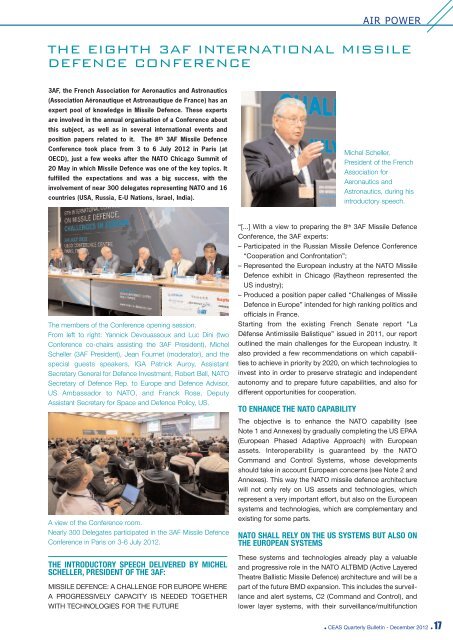Iam - CEAS. Council of European Aerospace Societies
Iam - CEAS. Council of European Aerospace Societies
Iam - CEAS. Council of European Aerospace Societies
Create successful ePaper yourself
Turn your PDF publications into a flip-book with our unique Google optimized e-Paper software.
3AF, the French Association for Aeronautics and Astronautics<br />
(Association Aéronautique et Astronautique de France) has an<br />
expert pool <strong>of</strong> knowledge in Missile Defence. These experts<br />
are involved in the annual organisation <strong>of</strong> a Conference about<br />
this subject, as well as in several international events and<br />
position papers related to it. The 8th 3AF Missile Defence<br />
Conference took place from 3 to 6 July 2012 in Paris (at<br />
OECD), just a few weeks after the NATO Chicago Summit <strong>of</strong><br />
20 May in which Missile Defence was one <strong>of</strong> the key topics. It<br />
fulfilled the expectations and was a big success, with the<br />
involvement <strong>of</strong> near 300 delegates representing NATO and 16<br />
countries (USA, Russia, E-U Nations, Israel, India).<br />
AIR POWER<br />
THE EIGHTH 3AF INTERNATIONAL MISSILE<br />
DEFENCE CONFERENCE<br />
The members <strong>of</strong> the Conference opening session.<br />
From left to right: Yannick Devouassoux and Luc Dini (two<br />
Conference co-chairs assisting the 3AF President), Michel<br />
Scheller (3AF President), Jean Fournet (moderator), and the<br />
special guests speakers, IGA Patrick Auroy, Assistant<br />
Secretary General for Defence Investment, Robert Bell, NATO<br />
Secretary <strong>of</strong> Defence Rep. to Europe and Defence Advisor,<br />
US Ambassador to NATO, and Franck Rose, Deputy<br />
Assistant Secretary for Space and Defence Policy, US.<br />
A view <strong>of</strong> the Conference room.<br />
Nearly 300 Delegates participated in the 3AF Missile Defence<br />
Conference in Paris on 3-6 July 2012.<br />
THE INTRODUCTORY SPEECH DELIVERED BY MICHEL<br />
SCHELLER, PRESIDENT OF THE 3AF:<br />
MISSILE DEFENCE: A CHALLENGE FOR EUROPE WHERE<br />
A PROGRESSIVELY CAPACITY IS NEEDED TOGETHER<br />
WITH TECHNOLOGIES FOR THE FUTURE<br />
“[...] With a view to preparing the 8 th 3AF Missile Defence<br />
Conference, the 3AF experts:<br />
– Participated in the Russian Missile Defence Conference<br />
“Cooperation and Confrontation”;<br />
– Represented the <strong>European</strong> industry at the NATO Missile<br />
Defence exhibit in Chicago (Raytheon represented the<br />
US industry);<br />
– Produced a position paper called “Challenges <strong>of</strong> Missile<br />
Defence in Europe” intended for high ranking politics and<br />
<strong>of</strong>ficials in France.<br />
Starting from the existing French Senate report “La<br />
Défense Antimissile Balistique” issued in 2011, our report<br />
outlined the main challenges for the <strong>European</strong> industry. It<br />
also provided a few recommendations on which capabilities<br />
to achieve in priority by 2020, on which technologies to<br />
invest into in order to preserve strategic and independent<br />
autonomy and to prepare future capabilities, and also for<br />
different opportunities for cooperation.<br />
TO ENHANCE THE NATO CAPABILITY<br />
Michel Scheller,<br />
President <strong>of</strong> the French<br />
Association for<br />
Aeronautics and<br />
Astronautics, during his<br />
introductory speech.<br />
The objective is to enhance the NATO capability (see<br />
Note 1 and Annexes) by gradually completing the US EPAA<br />
(<strong>European</strong> Phased Adaptive Approach) with <strong>European</strong><br />
assets. Interoperability is guaranteed by the NATO<br />
Command and Control Systems, whose developments<br />
should take in account <strong>European</strong> concerns (see Note 2 and<br />
Annexes). This way the NATO missile defence architecture<br />
will not only rely on US assets and technologies, which<br />
represent a very important effort, but also on the <strong>European</strong><br />
systems and technologies, which are complementary and<br />
existing for some parts.<br />
NATO SHALL RELY ON THE US SYSTEMS BUT ALSO ON<br />
THE EUROPEAN SYSTEMS<br />
These systems and technologies already play a valuable<br />
and progressive role in the NATO ALTBMD (Active Layered<br />
Theatre Ballistic Missile Defence) architecture and will be a<br />
part <strong>of</strong> the future BMD expansion. This includes the surveillance<br />
and alert systems, C2 (Command and Control), and<br />
lower layer systems, with their surveillance/multifunction<br />
• <strong>CEAS</strong> Quarterly Bulletin - December 2012 • 17



